Most traditional festivals in Japan are dedicated to Shinto deities (kami) and their shrines. For example, Nada no Kenka Matsuri honors Hachiman, the deity of archery and war. It is held at Matsubara Hachiman Shrine. The matsuri is referred to as a “fighting festival” because instead of simply carrying portable shrines (mikoshi) in a procession, its participants slam them into one another in a display of dominance.
A mikoshi is a portable Shinto shrine used to transport a deity from the main shrine to a temporary one during a festival, or to move it to a new permanent shrine. During festivals involving mikoshi, people bear portable shrines on their shoulders by means of poles and carry them around in a colorful procession.
The Nada Fighting Festival, however, is different from most matsuri involving portable shrines. In addition to mikoshi processions, it involves kenka (“fighting”), the ritual of driving three portable shrines directly into each other to please the god of war.
The ritual involves three mikoshi shrines: the lightest one is carried by men aged 16 to 25 wearing red headbands, the second one is carried by men aged between 26 and 35 wearing yellow headbands, and the heaviest one is carried by men between 36 and 45 wearing white headbands. The youngest participants can use bamboo poles in the fighting. Setting the shrines on their shoulders, the participants knock them against one another until one of the mikoshi breaks. The fight is spectacular and can get quite brutal!
Another tradition of the Nada Fighting Festival is a parade carrying competition of seven yatai (ornate floats). On the evening of October 14, yatai from seven local villages are carried to the shrine. The next day, yatai participate in a carrying competition against each other, which is much less brutal than mikoshi fighting because yatai are lavishly decorated and therefore extremely expensive.
Every year, the festival attracts over 100,000 spectators. However, all seats are reserved for the locals. If you’re a tourist, you need to be invited by one of the locals. Standing seats are available for everyone, but they are a little bit far from the epicenter of the events.

Photo: Daniel Beresford



